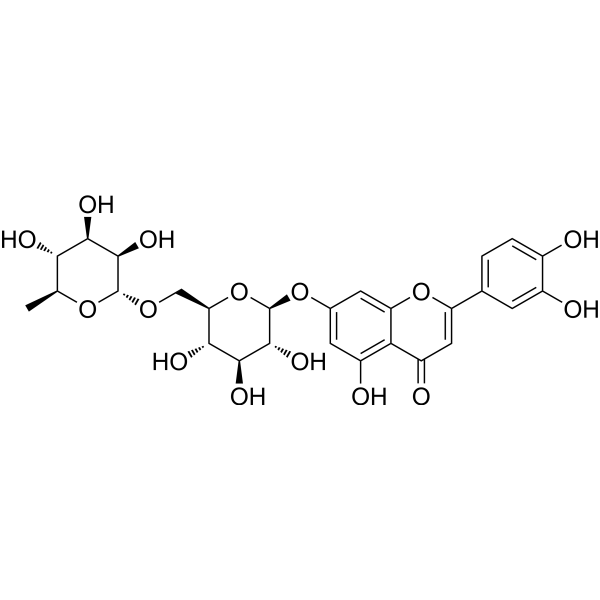
Luteolin 7-rutinoside
CAS No. 20633-84-5
Luteolin 7-rutinoside( —— )
Catalog No. M31825 CAS No. 20633-84-5
Luteolin-7-rutinoside has both antifungal activities and anti-arthritic, can result in a combination therapy for the treatment of fungal arthritis due to C. albicans infection.
Purity : >98% (HPLC)
 COA
COA
 Datasheet
Datasheet
 HNMR
HNMR
 HPLC
HPLC
 MSDS
MSDS
 Handing Instructions
Handing Instructions
| Size | Price / USD | Stock | Quantity |
| 10MG | 267 | In Stock |


|
| 50MG | Get Quote | In Stock |


|
| 100MG | Get Quote | In Stock |


|
Biological Information
-
Product NameLuteolin 7-rutinoside
-
NoteResearch use only, not for human use.
-
Brief DescriptionLuteolin-7-rutinoside has both antifungal activities and anti-arthritic, can result in a combination therapy for the treatment of fungal arthritis due to C. albicans infection.
-
DescriptionLuteolin-7-rutinoside has both antifungal activities and anti-arthritic, can result in a combination therapy for the treatment of fungal arthritis due to C. albicans infection.
-
In VitroAt a dose of 10 μg Luteolin-7-rutinoside (lonicerin)/mL, there is an approximately 47% decrease of the proliferation as compared to proliferation of Luteolin-7-rutinoside treated (control) T cells (p<0.05). Luteolin-7-rutinoside at 40 μg/mL dose give almost the same rate of T cell proliferation as does 20 μg/mL dose of Luteolin-7-rutinoside. The suppressive activity is dose dependent. Luteolin-7-rutinoside treatment swifts Th1-Th2 balance away from Th1-toward Th2-type responses. Luteolin-7-rutinoside inhibits nitric oxide (NO) production from macrophages.
-
In Vivo——
-
Synonyms——
-
PathwayOthers
-
TargetOther Targets
-
Recptor——
-
Research Area——
-
Indication——
Chemical Information
-
CAS Number20633-84-5
-
Formula Weight594.52
-
Molecular FormulaC27H30O15
-
Purity>98% (HPLC)
-
SolubilityIn Vitro:?DMSO : 100 mg/mL (168.20 mM)
-
SMILES——
-
Chemical Name——
Shipping & Storage Information
-
Storage(-20℃)
-
ShippingWith Ice Pack
-
Stability≥ 2 years
Reference
molnova catalog



related products
-
Thalidomide-O-amido-...
Thalidomide-O-amido-C4-NH2 TFA is a synthesized E3 ligase ligand-linker conjugate.
-
Desbenzyl Donepezil ...
Used as organic synthesis and medicine intermediate.
-
Difluprednate
A FDA approved topical corticosteroid indicated for the treatment of inflammation and pain associated with ocular surgery.



 Cart
Cart
 sales@molnova.com
sales@molnova.com


